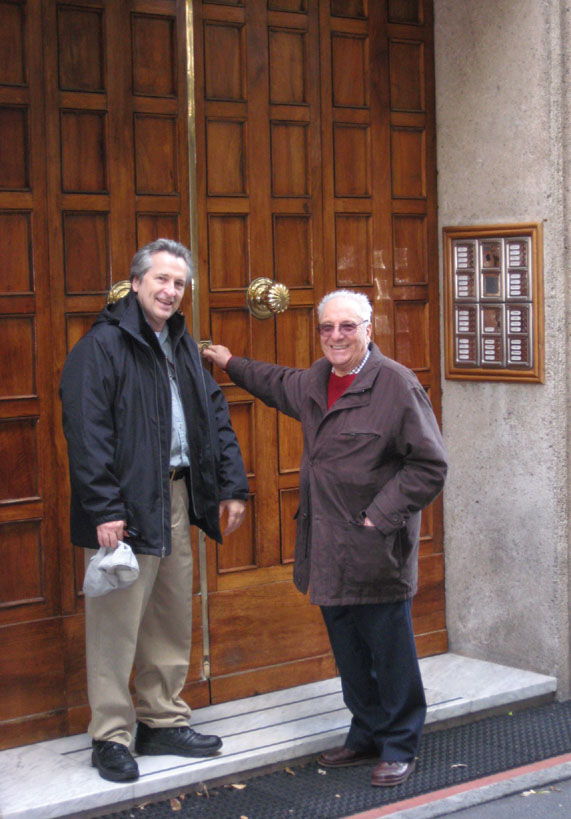By now, most readers have probably caught up with my first-time adventures in Genoa (Genova), Italy two years ago. So – could I recapture the magic? Yes, and no. Nothing can compare to that first impression, the emotions, the city, the new friends and the ridiculous amount of new instrument discoveries (and always that “following in the footsteps of Taraffo” vibe). Seriously, how spoiled can one possibly get? But Jaci and I could not wait to get back and see old sights, hopefully, some new sights, and of course, the many special friends that are forever in our hearts. And if all went well, a short side trip to Milan in the middle of the week would supply enough new harp guitar adventures to warrant another tax write-off…
And so we begin, pretty much where we left off…with my esteemed and tireless Taraffo research collaborator, Franco Ghisalberti, once again hosting us for the journey.

Leaving at the crack of dawn on Friday, April 6th meant we would finally arrive in Genoa on what was then Saturday afternoon, after the expected 20+ tedious hours of travel. We were dutifully picked up by Franco, family and friends in two cars as I was hauling an empty CaseXtrme harp guitar flight case as luggage (as Chico Marx says in Cocoanuts, “We fill it up before-a we leave.”).
We would stay with Franco at his city home for this trip (with the amazing Margherita, his aide, who has been with the family for 12 years). It was pretty much as I remembered; with his own small harp guitar collection now hanging in the rear foyer (you saw all these instruments in our last adventure).

It was a short day of visiting, dinner, and an early bedtime – but not before unveiling the prize I had brought the case for.

As readers might remember, I closed 2010’s trip report with the mention that new friend, violin expert Alberto Giordano, had tracked down this rare instrument in a Paris shop, which he eventually acquired for me, after negotiating it down to a manageable price. After a full inspection (Alberto being a knowledgeable expert on this maker) he delivered it to Franco, to await my return (we discussed shipping options, but, frankly, I think Franco kept it as “bait” to entice us to return…).
It needs just a bit of restoration and re-stringing and should then be a pretty stunning piece. It was built in Genoa, circa 1920 (definitely by 1922, as indicated by the label style) by Paolo De Barbieri (1889-1962), one of Cesare Candi’s top protégés. Typically, guitars and the occasional mandolin were just a small sideline for these top violin-makers.

It was this style of Candi harp guitar that I have long lusted after, with the only example I know of (above) – built by Oreste Candi (1865-1938), brother of Cesare (1869-1947) – being in the possession of Riccardo Marasco (an important instrument that sadly defies our attempts to obtain photos or crucial dating information). I found it interesting and certainly not a coincidence that the design of this distinctive and attractive “lap held” instrument is so similar to the original floor-standing Candi “chitarpa” created in the early 1900s (below). As if the brothers just sort of “sectioned off” the real estate of the pedestal area to leave themselves with a more practical harp guitar. Or was it vice versa?

You may remember the three recently-discovered instruments by Priano (which I introduced in the 2010 report, of which 2 are seen flanking a Gazzo in the first photo above) – which also clearly show this Candi influence (including the carved appliqués on the corners), but De Barbieri was directly following his teacher’s lead. Note that his has the same distinctive headstock shape as on Cesare’s 9-string, and how the instrument seems even closer in style to the top portion of Cesare’s floor-standing chitarpa.
Alberto (who has seen more of these rare Genovese maker instruments than anyone) has seen a couple of De Barbieri 6-string guitars, a single 3-bass theorbo-style instrument, and this single hollow-arm specimen. It’s all the more special in having a full eight sub-basses, which of course, is Pasquale Taraffo’s own configuration. Despite his popularity and influence, however, nearly all other players (and instruments) stuck to just 3 to 6 basses.
I’ll do a more in-depth feature on the De Barbieri once restored, with more on the wonderful harp guitars of the Candi brothers and their followers.
Sorry to ramble…as you can imagine, despite my exhaustion, it was hard to fall asleep with these geeky guitar thoughts churning around in my head…!
Next time: Easter Sunday with the Ghisalberti family






Woah Gregg,
Great report on all things Harp Guitar Italia! It always amazes me how early instrument makers were so innovative.
The Larson Bros. on this side of the Atlantic are a good example, but in Europe there were many unique instrument
builders too. Their work never ceases to amaze me!
That’s it; I thought it might be walnut,but it was the staining.
Bernie – I highly doubt it’ll create a new fad. It’s common local pine, grainy and knotty, stained to match the walnut back and sides.
Oh my, the top on your new Barbieri is stunning! What are the woods; top, sides and back? I don’t think I could sleep until it was restored and I was able to play it!
Thanks for the trip to Brussels! 😉